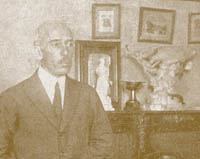|
In 1909, the Brazilian Santos-Dumont designed, built and flew the ‘Demoiselle’, a precursor to the modern light plane. In its first flight that same year it traveled more than 200 meters at a speed of close to 100 km./hr. It was the last airplane built by this pioneer of aviation in a brief but successful career. Alberto Santos-Dumont was born on July 20, 1873, in Cabangu, Palmira (present-day Santos-Dumont), in the state of Minas Gerais in Brazil.
When he was eighteen years old he moved with his family to Paris, where he received an intense technical education by request of his father who saw the future of humanity in physics, chemistry, and mechanics. Early on he became interested in flight and in 1898 he went up on his first balloon named ‘Brazil’. After several experiences with varying degrees of success, he focused his attention on the subject of balloon travel. In 1899, with Santos-Dumont #3, he succeeded in traveling around the Eiffel Tower and landing without problem in a nearby park. On October 19, 1901, with his balloon #6, he departed the field of Saint Cloud, rounded the Eiffel Tower and returned to the starting point in less than thirty minutes. This accomplishment won him the 100,000 franc Deutsch Prize which, it must be noted, he distributed among his workers and the poor in Paris.
Having solved the problem of controlling a vehicle ‘lighter than air’, Santos-Dumont focused on inventing a flight vessel ‘heavier than air’. On October 23, 1906, in front of a crowd of spectators and representatives of the Aero Club of France, the self-propelled Santos-Dumont #14-bis rolled on ground for 100 meters, took off and flew 60 meters in seven seconds at only a few meters above the runway. With this accomplishment he won the Archdeacon Prize founded by the American Ernest Archdeacon in July of 1906, to be awarded to the first aviator to fly more than 25 meters. On November 12 of the same year, Santos-Dumont succeeded in setting the first world record in aviation by flying 220 meters in less than 22 seconds. But, more importantly, he officially resolved the problem of getting a machine that is ‘heavier than air’ to take off the ground by its own means.
His determination to outdo himself left the aeronautic industry with much to be thankful for. His 14-bis already included ailerons in the wings that served to control the movement of the plane, and among his most advanced developments was the delta wing, invented forty years before it became widely used in the industry. Alberto Santos-Dumont died on July 23, 1932, in the small town of Guaruja, Sao Paulo, Brazil. He was posthumously appointed ‘General of the Air’ in the Brazilian Air Force and ‘Father of Aviation’. He holds an honorable place in the Smithsonian Institute and in 1967 was introduced to the Hall of Fame of International Aerospace. Alberto Santos-Dumont, an example of the best of the latin spirit. |
|
|
 Could
a Latino have built the first sports plane in the world?
Could
a Latino have built the first sports plane in the world?